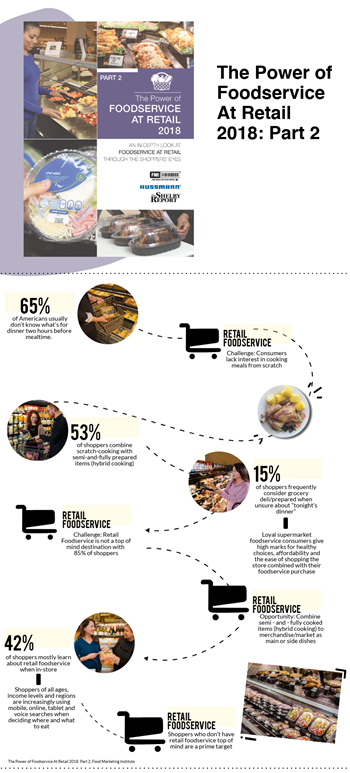FMI Analysis Reveals Business Strategies for Engaging the Grocery Foodservice Customer
ARLINGTON, VA – Food Marketing Institute (FMI) today released an update to its 2018 Power of Foodservice at Retail analysis that offers more perspective on purchase behavior and ways to connect with consumers who, in general, are cooking less. The analysis demonstrates that a modern lens on convenience, health and freshness are the trifecta for supporting a competitive foodservice growth strategy in food retail.
In the last five years, food spending for meals prepared at home witnessed 5% growth while spending on meals prepared away from home increased 20%, according to Bureau of Labor Statistics. Spontaneous dinner decisions are now an inherent part of the shopper psyche, and a consequence is lower average weekly spending in the grocery store. The Power of Foodservice at Retail - Part 2 suggests that food retailers can assist shoppers in their weekly menu planning and prove the convenience value of retail foodservice. In fact, nearly two-thirds of consumers already incorporate time-saving solutions when preparing dinner in the form of semi- and fully-prepared items, such mixing scratch cooking with value-added meat or produce, heat-and-eat mashed potatoes or ready-to-eat meat.
 FMI Vice President, Fresh Foods, Rick Stein said, “Our research shows that an overwhelming 65% of consumers have not made up their mind on what to eat for dinner by 4 p.m., so this trend of consumers partnering scratch-cooking with time-saving meal accompaniments aligns well with grocers’ merchandising and marketing strategies. The research also shows that those loyal supermarket foodservice consumers give high marks for healthy choices, affordability and the ease of shopping the store combined with their foodservice purchase.”
FMI Vice President, Fresh Foods, Rick Stein said, “Our research shows that an overwhelming 65% of consumers have not made up their mind on what to eat for dinner by 4 p.m., so this trend of consumers partnering scratch-cooking with time-saving meal accompaniments aligns well with grocers’ merchandising and marketing strategies. The research also shows that those loyal supermarket foodservice consumers give high marks for healthy choices, affordability and the ease of shopping the store combined with their foodservice purchase.”
Seven in 10 shoppers emphasize healthy, nutritious choices when ordering from retail foodservice or restaurants. While 68% of shoppers believe they have sufficient information to make educated decisions, many emphasize the importance of options in the deli/prepared foods department, led by healthier ingredients (85%), clean label items (83%) and in-store health and nutrition information and/or education (71%). Switching to better-for-you alternatives is a popular tactic employed among health-focused shoppers and foodservice regulars.
Stein continued, “Food retailers who embrace health, quality, convenience and another critical lifestyle consideration – a more digitally-engaged foodservice consumer – will be the most successful in this competitive landscape as solution providers. In fact, the study notes that shoppers who are more likely to use technology for dinner planning tend to eat out an average of three times per week.”
Researchers surveyed shoppers about their dinner routines, channel choices, the importance of promotions, technology, health and wellness and assortment in addition to recommendations on how their primary retail foodservice department could improve. The Power of Foodservice at Retail 2018 – Part 2 was conducted by FMI, prepared by 210 Analytics and supported by The Shelby Report and Hussmann Corporation. To download a copy of the report, visit www.fmi.org/store Industry Topics address your specific area of expertise with resources, reports, events and more.
Industry Topics address your specific area of expertise with resources, reports, events and more.
 Our Research covers consumer behavior and retail operation benchmarks so you can make informed business decisions.
Our Research covers consumer behavior and retail operation benchmarks so you can make informed business decisions.
 Events and Education including online and in-person help you advance your food retail career.
Events and Education including online and in-person help you advance your food retail career.
 Food Safety training, resources and guidance that help you create a company food safety culture.
Food Safety training, resources and guidance that help you create a company food safety culture.
 Government Affairs work — federal and state — on the latest food industry policy, regulatory and legislative issues.
Government Affairs work — federal and state — on the latest food industry policy, regulatory and legislative issues.
 Get Involved. From industry awards to newsletters and committees, these resources help you take advantage of your membership.
Get Involved. From industry awards to newsletters and committees, these resources help you take advantage of your membership.
 Best practices, guidance documents, infographics, signage and more for the food industry on the COVID-19 pandemic.
Best practices, guidance documents, infographics, signage and more for the food industry on the COVID-19 pandemic.
